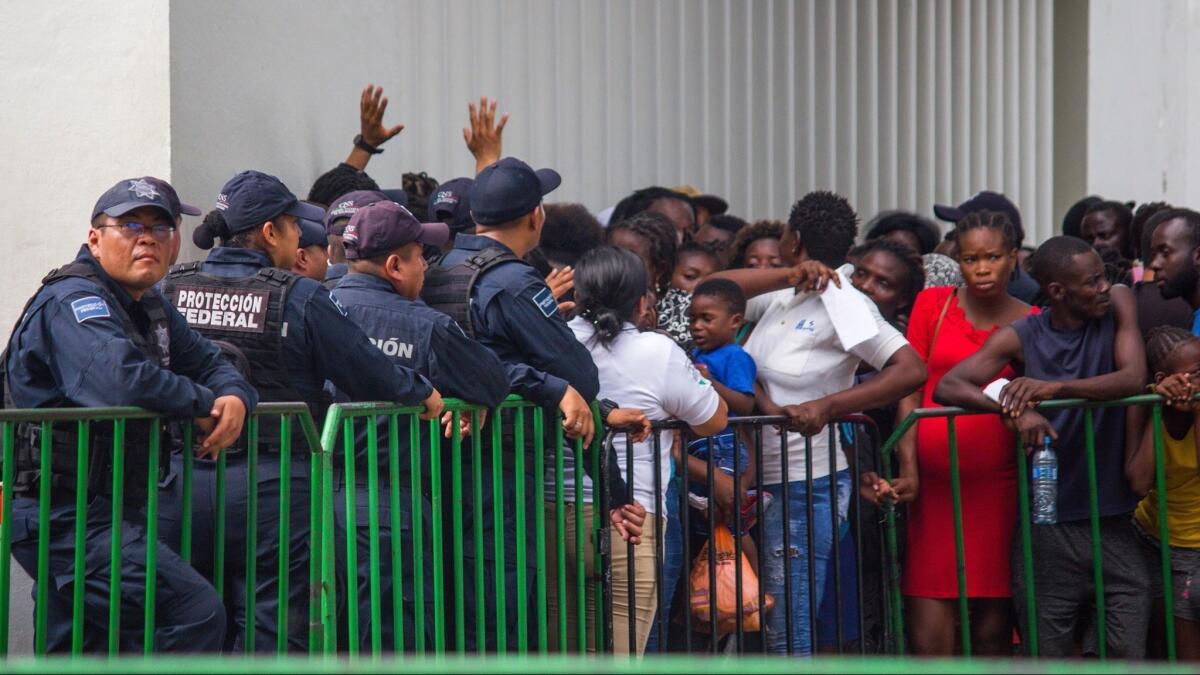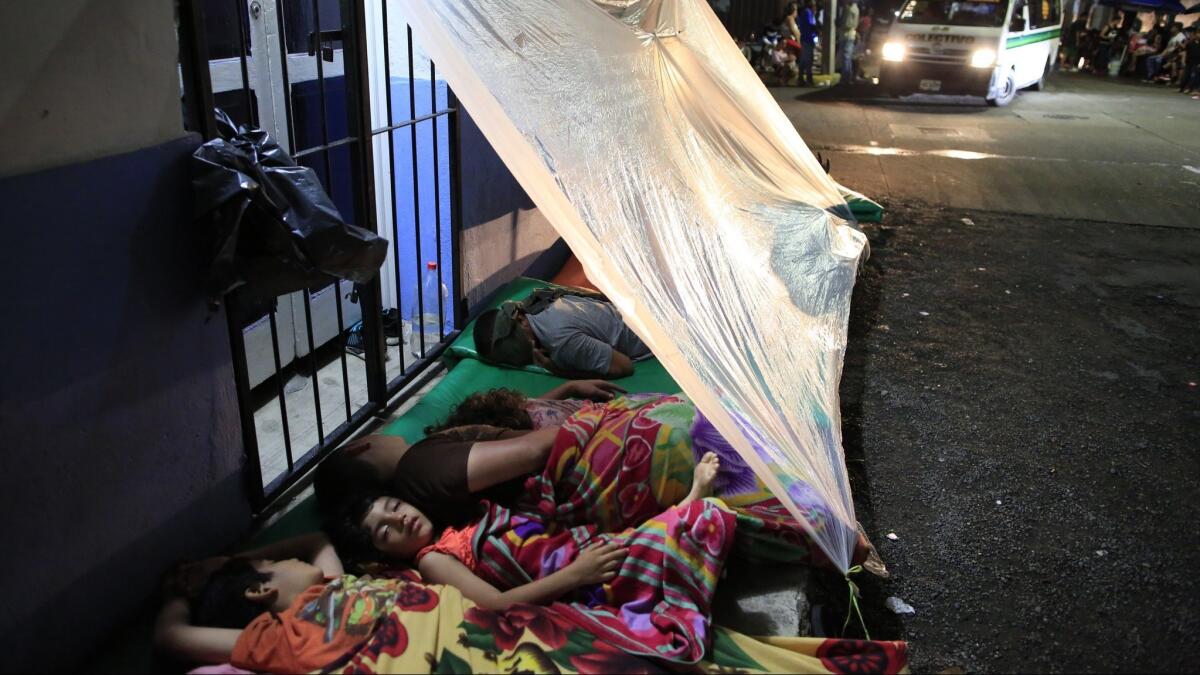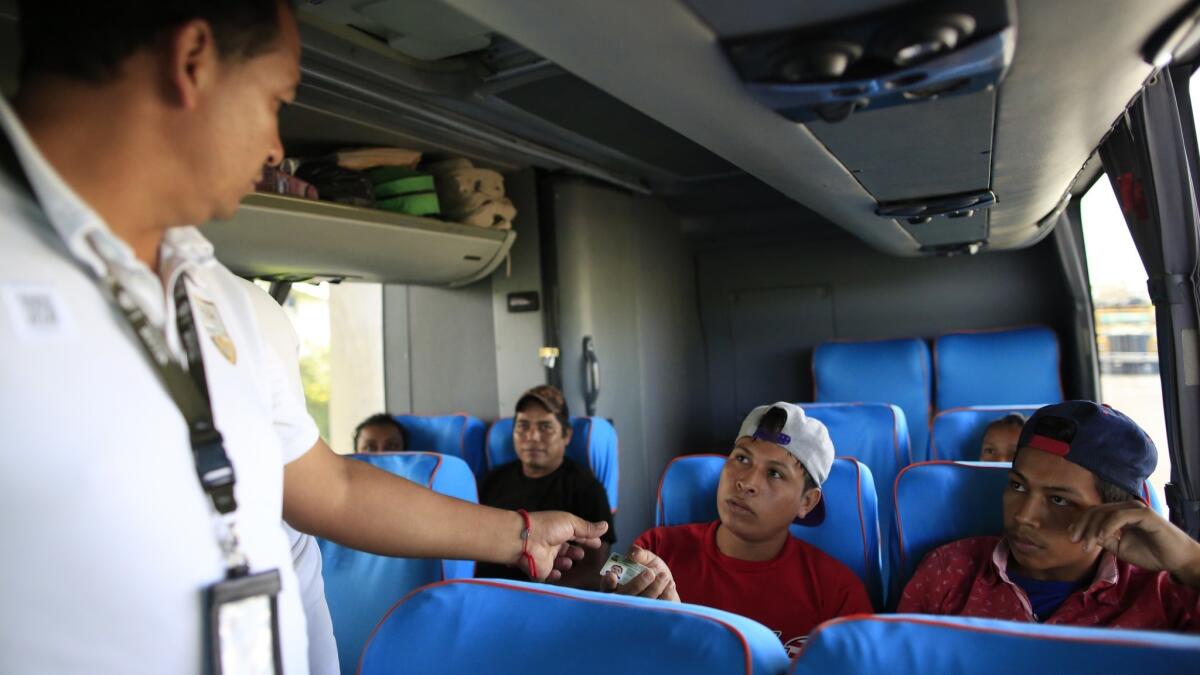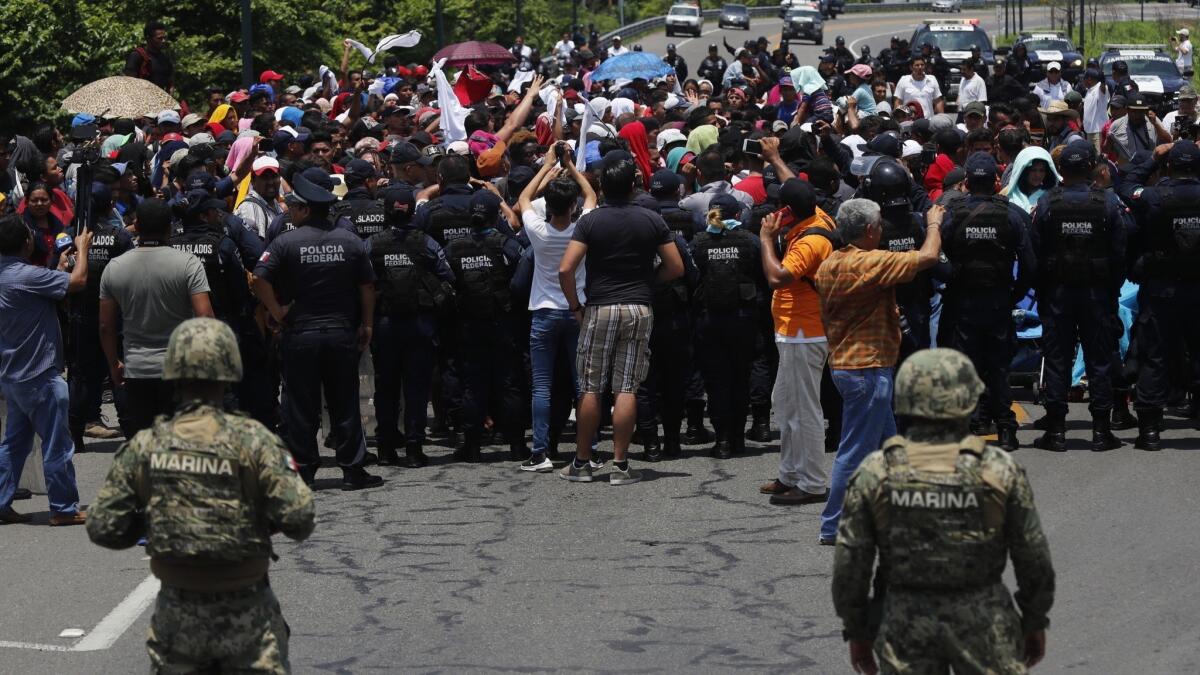At Mexicoâs southern border, migrants feel the pinch of a crackdown spurred by U.S.

Reporting from Tapachula, Mexico â Long lines of migrants, mostly Central Americans, line up daily outside the Tapachula offices of the refugee agencies of Mexico and the United Nations.
Meanwhile, a polyglot throng including people from Africa, Asia and the Caribbean regularly gathers at the local headquarters of the National Institute of Immigration, Mexicoâs agency for migrant affairs.
Almost all those seeking help have a common destination â the United States â but they find themselves caught in an expanding Mexican immigration crackdown prompted by U.S. pressure and marooned in this sweltering city in southern Mexico.
They cannot proceed north without risking arrest, so they remain in Tapachula seeking documentation allowing legal travel to the U.S.-Mexico border, more than 1,000 miles away. They say they are fleeing poverty and violence in their homelands.
Maribel Amador and her family were among those gathered on a recent afternoon outside the offices of the Mexican Refugee Assistance Commission.
âThere is nothing we can do but wait,â said Amador, 36, a Honduran national seeking refugee status in Mexico along with her husband and four children, ages 5 to 14, though the family hopes to make it to the United States. âWe canât move forward without papers.â
A surge this year in migrants from Central America to the United States to levels not seen in at least a decade generated a threat by President Trump to impose tariffs on imports of Mexican goods if Mexico did not move to stem the flow of U.S.-bound migrants traversing the country.
In recent weeks, Mexican authorities have set up immigration checkpoints along the main northbound highway and have been aggressively detaining and deporting thousands of migrants.
The law enforcement squeeze seems destined to tighten with Mexicoâs vow to deploy about 6,000 national guard forces to its southern border as part of a deal reached last week with the Trump administration to avert U.S. tariffs.
Mexico has 45 days to demonstrate that the northbound flows of migrants are declining, or the two sides go back to the negotiating table, with Mexico in a weakened position, Marcelo Ebrard, the countryâs foreign secretary, said Tuesday.
A key question is whether Mexican authorities can overcome long-entrenched corruption that has seen police and immigration agents historically working in cahoots with smugglers, enabling vehicles packed with migrants to continue their journeys.
âYou can stop a couple of thousand people in Tapachula, but if [immigration] officers are still letting people go through in buses, because they have deals with the smugglers, it wonât make much of a difference,â said Stephanie Leutert, director of the Mexican Security Initiative at the University of Texas at Austin. âIt will require a lot of political will.â
The Mexican strategy is a familiar one: Position checkpoints on the limited number of roads radiating north from the notoriously porous Guatemalan border, which stretches for about 600 miles along jungle, mountain and river terrain. The idea is to bottle up and detain migrants in the south. Mexico also appears to have stepped up enforcement against northbound freight trains, another popular mode of migrant travel.
In March, the Mexican interior secretary, Olga Sanchez Cordero, said Mexico planned to create an enforcement containment belt along the Isthmus of Tehuantepec, Mexicoâs narrowest point, about 125 miles across from the Pacific to the Gulf of Mexico, to keep the migrant flow from advancing north.
The current scenario in the southern state of Chiapas is far removed from the atmosphere of months past, when tens of thousands of Central Americans â in organized caravans and in small groups â moved freely through the corridor. Many were quickly granted humanitarian visas as part of Mexican President Andres Manuel Lopez Obradorâs vow to assist migrants. The welcome mat has now been yanked.

Mexican officials reported deporting more than 30,000 foreigners during April and May, almost 70% more than during the same period a year earlier. Police also broke up the two most recent northbound migrant caravans, arresting hundreds.
The enhanced enforcement, however, is unfolding amid what Mexico calls a massive flow of U.S.-bound migrants. The number could reach 900,000 this year â including what Mexican officials say are unprecedented numbers of women and children, mostly from Honduras and Guatemala. Mexico says the numbers represent about double the figures in recent years.
On the main northbound thoroughfare, the Coastal Highway, which parallels the nearby Pacific, immigration agents, federal police and military officers stop northbound buses, cars and minivans, demanding that passengers produce documents. Those lacking papers showing legal status are escorted away to immigration vans.
âWe are here to provide some order,â said a military policeman helping to staff a checkpoint south of Tapachula.
âWe canât have an uncontrolled movement into our country,â said the officer, who declined to give his name because he was not authorized to speak publicly.
Migrants who make it to Tapachula, about 20 miles north of the Guatemalan border, say they have little choice but to remain and apply for immigration paperwork â visas, temporary visitor permits, refugee status or departure documents that give recipients 30 days to get out of Mexico. But it has become a tortuous waiting game.
The escalating demand has overwhelmed the understaffed immigration bureaucracy, which has also suffered budget cuts. The countryâs refugee agency expects that applications will more than double this year to more than 80,000 from 29,000 last year.

While Central Americans represent the majority of migrants converging in the shadow of the Tacana volcano, huge numbers of so-called extracontinentales from across the globe also have made the trek.
âI am here now, free today, but I may be arrested today or tomorrow and deported,â said Nesly Simeon, 28, a Haitian national who was among those gathered recently outside the immigration agency in Tapachula, known as Siglo XXI, or 21st Century. âWe are here waiting and waiting.â
Also in line was Oru Samuel Arrah, 38, among a group of more than two dozen nationals from the African nation of Cameroon.
âWe want to go to America; we donât want to be here,â said Arrah, adding that he was a technical engineer in his homeland but faced political repression there. âWhy doesnât Mexico allow us to go?â
Many migrants cross illegally into Mexico on rafts crafted of wooden planks and inner tubes across the Suchiate River, which marks the Guatemalan-Mexican frontier.
âWe mostly see Cubans, Haitians, Africans now,â said Rigoberto Vasquez, known as El Conejito, or Little Rabbit, who has worked the raft enterprise for 35 years, moving merchandise and people from his muddy riverfront depot, across from a lively outdoor bar-restaurant.
The Mexican clampdown and the planned national guard deployment have yielded protests against a U.S.-style militarization of Mexicoâs southern frontier, which critics liken to Trumpâs attempts to build a wall along the U.S.-Mexico border.
âIf we as Mexicans have rejected the construction of a wall, we cannot turn ourselves into that wall,â Mexicoâs Catholic Conference of Bishops said in a statement Monday.
Hundreds of detainees â many of them Cuban â have staged jailbreaks from the immigration lockup at Siglo XXI.
âWe are fleeing a dictatorship,â said Marwin Delgado, 35, an athletic trainer from Cuba, who, with his partner, Yurima Fernandez, 27, a physician, were among those waiting on a recent afternoon outside the Mexican refugee agency as a steady beat of cumbia emanated from a dance studio across the street. âWe have families in the United States. But the Mexicans donât want to help us.â

Those with access to cash can turn to smugglers, or coyotes, skilled at circumventing checkpoints â and known for paying off Mexican officials.
But smuggling fees can run to $5,000 or more per person for passage to the border, with clients often jammed dangerously into the rear of crowded trucks navigating back roads.
Many people lacking such funds take temporary jobs in Tapachula as laborers and cooks and in other menial positions to help buy food and rent cheap housing. A dozen or more people are often crammed into single rooms, sleeping on mats and blankets.
Migrants gather daily beneath shade trees in Tapachulaâs central plaza, waiting for food handouts.
Down the street from the Siglo XXI immigration facility, a shantytown of mostly Haitians and Africans awaiting departure papers has sprouted, giving the zone a distinct Afro-Caribbean vibe. Many of the migrants began their journeys in South America. Many Haitians previously worked in Brazil and Chile, making the overland odyssey through mountains, jungles and rivers.
âThere were no more jobs in Brazil, so we went to Chile,â said Simeon, the Haitian migrant. âThen the Chileans didnât want us anymore.â
Some frustrated migrants try to sneak north in stages, taking public minibuses to points just before immigration checkpoints, then hiking around the barriers, before jumping on other northbound transport. But thieves and kidnappers sometimes lurk in the bush.
âThey attacked us, but we managed to fight them off and escape,â said Teresa Mayadal, 46, a chemical technician from Havana who, along with her husband, made it to the Mexican city of Arriaga, a freight train terminus about 150 miles north of Tapachula.
Her feet were heavily bandaged, the result of blisters from days of walking north from the Guatemalan border. For good luck, she cradled a blue-and-white doll of Santeria, a popular folk religion of African origins, as she and her husband rested on cardboard sheets and blankets outside a migrant shelter in Arriaga.
Sitting next to her was a Honduran woman, 21, with tears in her eyes. She said â her voice breaking â she had been sexually assaulted while walking around a checkpoint. The assailants also stole her cellphone and her purse. She asked some visitors whether she could borrow a phone to call her boyfriend in the United States, and sought the equivalent of $1 to pay for a shower at a private home.
Her name was Larisa, she said, declining to provide a surname.
âI never thought this would happen,â she said, holding back tears.
The lucky ones, like Jose Mario Barralaga, 28, from La Ceiba, Honduras, obtained humanitarian visas allowing them unfettered travel through Mexico. But Barralaga â who says he was shot by gang members in La Ceiba and left for dead because he refused extortion threats â plans to wait in Tapachula several more weeks with his wife and two children while saving a few hundred dollars for the trip to the U.S. border.
âIn the United States, we have heard there is a chance of improvement for our families,â said Barralaga, who earns a living hawking homemade baleadas, a Honduran staple of flour tortillas stuffed with beans and cheese, to fellow migrants outside the Mexican refugee office. âThat chance for improvement is what we all hope for.â
Cecilia Sanchez of The Timesâ Mexico City bureau and special correspondent Liliana Nieto del Rio in Arriaga contributed to this report.
Twitter: @PmcdonnellLAT
More to Read
Sign up for Essential California
The most important California stories and recommendations in your inbox every morning.
You may occasionally receive promotional content from the Los Angeles Times.










